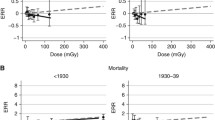Abstract
The purposes of this study were to determine whether exposure of the vestigial male breast to ionizing radiation is associated with an increase in risk of breast cancer and, if so, to determine whether the apparent effects on risk in men are similar to those reported for women. A population-based case-control study of breast cancer in men was conducted in 10 geographic areas of the United States. Information on possible prior exposure to ionizing radiation, and on other potential risk factors for breast cancer, was obtained from personal interviews of 227 cases and 300 controls who were recruited from October 1983 to September 1986. Evidence from this study that ionizing radiation can cause breast cancer in men includes: a modest trend of increasing risk with frequency of chest X-rays; an increase in risk in men with three or more radiographic examinations, especially if received prior to 1963; and an increase in risk in men who received X-ray treatments to the chest and adjacent body areas. Risk was increased only from 20 to 35 years after initial exposure from either radiographic examinations or X-ray treatments, and declined after three to four decades since last exposure, suggesting a wave of increased risk of finite duration following exposure. The doses of radiation received could not be estimated precisely, but those from diagnostic procedures were likely similar to those received by prepubertal females in prior studies, and the results of those and the present investigation are compatible. The carcinogenic effects of ionizing radiation may be similar in the male and prepubertal female breast.
Similar content being viewed by others
References
Tokunaga M, Land CE, Yamamoto T, et al. Incidence of female breast cancer among atomic bomb survivors, Hiroshima and Nagasaki, 1950–1980.Radiat Res 1987;12: 243–72.
Shore RE, Hempelmann L, Kowaluk E, et al. Breast neoplasms in women treated with X-rays for acute postpartum mastitis.JNCI 1977;59: 813–22.
Baral E, Larsson L, Mattsson B. Breast cancer following irradiation of the breast.Cancer 1977;40: 2905–10.
Hrubec Z, Boice JD Jr, Monson RR, Rosenstein M. Breast cancer after multiple chest fluoroscopies: second follow-up of Massachusetts women with tuberculosis.Cancer Res 1989;49: 229–34.
Miller AB, Howe GR, Sherman GJ, et al. Mortality from breast cancer after irradiation during fluoroscopic examinations in patients being treated for tuberculosis.New Engl J Med 1987;321 1285–9.
Stebbings JH, Lucas H, Stehney A. Mortality from cancers of major sites in female radium dial workers.Am J Indust Med 1984;5: 435–59.
Wang JX, Boice JD Jr, Li BX, Zhang JY, Fraumeni JF Jr. Cancer among medical diagnostic X-ray workers in China.JNCI 1988;80: 344–50.
Howe GP. Epidemiology of radiogenic breast cancer. In: Boice JD Jr, Fraumeni JF Jr, eds.Radiation Carcinogenisis: Epidemiology and Biological Significance. New York: Raven Press, 1984: 119–29.
Shore RE. Carcinogenic effects of radiation on the human breast. In: Upton AC, Albert RE, Burns FJ, Shore RE, eds.Radiation Carcinogenesis. New York: Elsevier, 1985: 279–91.
Hildreth NG, Shore RE, Dvorestsky PM. The risk of breast cancer after irradiation of the thymus in infancy.N Engl J Med 1989;321: 1281–4.
Fürst CJ, Lundell M, Holm LE, Silfverswärd C. Cancer incidence after radiotherapy for skin hemangioma: a retrospective cohort study in Sweden.JNCI 1988;80: 1387–92.
Modan B, Chetrit A, Alfandary E, Katz L. Increased risk of breast cancer after low-dose irradiation.Lancet 1989;2: 629–31.
Hoffman DA, Lonstein JE, Morin MM, Visscher W, Harris BSH III, Boice JD Jr. Breast cancer in women with scoliosis exposed to multiple diagnostic X-rays.JNCI 1989;81: 1307–12.
Williams MJ. Gynecomastia. Its incidence, recognition and host characteristics in 447 autopsy cases.Am J Med 1963;34: 103–12.
Schottenfeld D, Lilienfeld AM, Diamond H. Some observations on the epidemiology of breast cancer among males.Am J Public Health, 1963;53: 890–6.
Curtin CT, McHeffy B, Kolarsick AJ. Thyroid and breast cancer following childhood radiation.Cancer 1977;40: 2911–3.
Cohen R, Schauer PK. Male breast cancer following repeated fluoroscopy.Am J Med 1984;76: 929–30.
Olsson H, Ranstam J. Head trauma and exposure to prolactin-elevating drugs as risk factors for male breast cancer.JNCI 1988;80: 679–83.
Casagrande JT, Hanisch R, Pike MC, Ross RK, Brown JB, Henderson BE. A case-control study of male breast cancer.Cancer Res 1988;48: 1326–30.
Thomas DB, Jimenez LM, McTiernan A, et al. Breast cancer in men: risk factors with hormonal implications.Am J Epidemiol 1992;135: 734–48.
McTiernan A, Thomas DB, Whitehead A, Noonan E. Efficient selection of controls for multi-centered collaborative studies of rare diseases.Am J Epidemiol 1986;123: 901–4.
Beslow NE, Day NE.The Analysis of Case-control Studies. Statistical Methods in Cancer Research. Volume 1. Lyon, France: International Agency for Research on Cancer, 1980; IARC Sci. Pub. No. 32.
National Research Council.Health Effects of Exposure to Low Levels of Ionizing Radiation. BEIR V: Washington, DC: National Academy Press, 1990: 5.
Boice JD Jr, Rosenstein M, Trout ED. Examination of breast doses and breast cancer risk associated with repeated fluoroscopic chest examinations of women with tuberculosis.Radiat Res 1978;73: 373–90.
Tucker MA, Meadows AT, Boice JD Jr, Hoover RN, Fraumeni JF Jr. Cancer risk following treatment of childhood cancer. In: Boice JD Jr, Fraumeni JF Jr, eds.Radiation Carcinogenesis: Epidemiology and Biological Significance. New York: Raven Press, 1984: 211–24.
Moolgavkar SW, Day NE, Stevens RG. Two-stage model for carcinogenesis: epidemiology of breast cancer in females.JNCI 1980;65: 559–69.
Author information
Authors and Affiliations
Additional information
This study was funded by grant No. R01 CA 35653 from the US National Cancer Institute.
Rights and permissions
About this article
Cite this article
Thomas, D.B., Rosenblatt, K., Jimenez, L.M. et al. Ionizing radiation and breast cancer in men (United States). Cancer Causes Control 5, 9–14 (1994). https://doi.org/10.1007/BF01830721
Received:
Accepted:
Issue Date:
DOI: https://doi.org/10.1007/BF01830721




